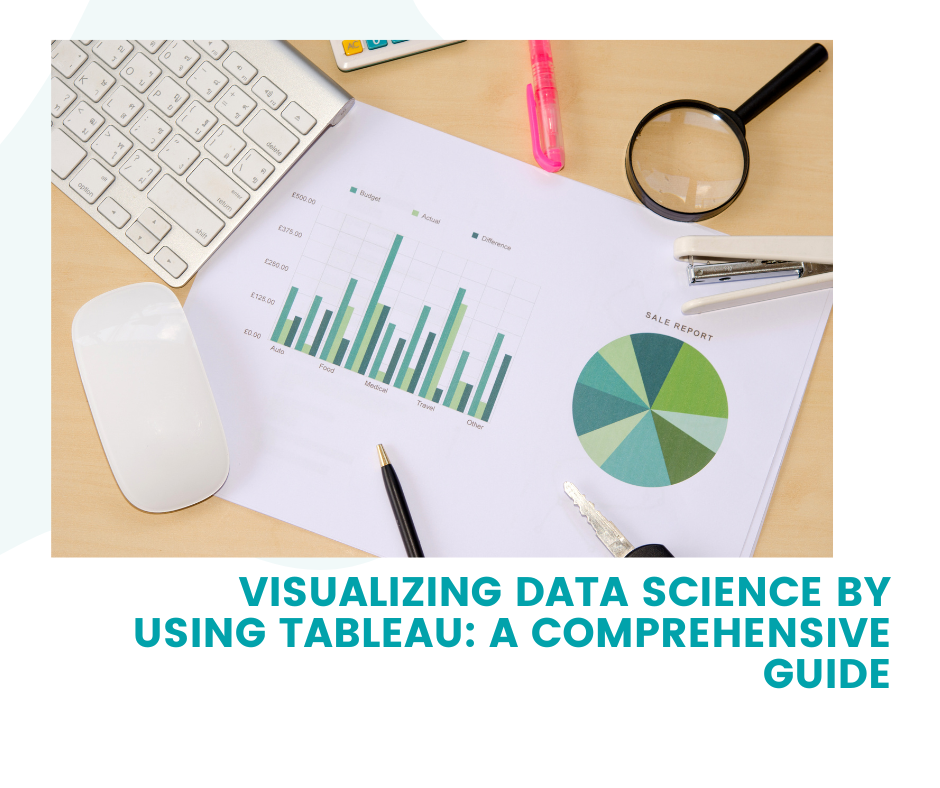Visualizing Data Science by Using Tableau: A Comprehensive Guide
 Ruhi Parveen
Ruhi Parveen
In today’s data-driven world, effective data visualization tools are essential for making informed decisions. Tableau, a leading data visualization software, provides robust features to transform raw data into visually appealing and interactive insights. This guide covers how to use Tableau to visualize data science projects effectively, with a focus on readability and practical application.
What is Tableau?
Tableau is a powerful data visualization tool that helps analysts, data scientists, and business users create interactive, shareable dashboards. These dashboards simplify complex data analyses by providing easy-to-read visual representations, such as charts, graphs, and maps. Tableau can connect to various data sources, allowing users to analyze data quickly and communicate insights clearly.
Key Features of Tableau
Drag-and-Drop Interface: Allows easy customization of data visualizations.
Data Blending: Merges data from multiple sources for integrated insights.
Interactive Dashboards: Offers highly interactive, shareable visualizations.
Real-Time Analysis: Connects to live data for real-time updates.
Extensive Integration: Compatible with databases like SQL, cloud platforms, and Excel.
Why Use Tableau in Data Science?
Data scientists work with large datasets to uncover patterns and insights. Tableau supports this process by providing tools that convert raw data into meaningful visual representations. Here are some reasons why Tableau is valuable for data science:
Improves Data Understanding: Visualizations make complex datasets easier to understand.
Speeds Up Analysis: The drag-and-drop interface accelerates exploratory data analysis.
Enhances Decision-Making: Interactive dashboards provide actionable insights.
Facilitates Collaboration: Shareable dashboards help teams work on data-driven decisions together.
Getting Started with Tableau
Step 1: Install Tableau
You can download and install Tableau Desktop from the official website. Tableau offers a free version called Tableau Public, which is suitable for beginners.
Step 2: Import Data
Once installed, open Tableau and import your dataset. You can import data from various sources:
Excel
CSV files
SQL databases
Cloud services (like Google Sheets or AWS)
Step 3: Data Preparation and Cleaning
Before creating visualizations, it’s crucial to clean and prepare your data. Tableau provides tools like Data Interpreter and Data Prep to help you clean, transform, and organize your data for effective analysis.
Basic Data Visualization Techniques in Tableau
1. Creating a Bar Chart
Bar charts are useful for comparing categorical data. In Tableau, creating a bar chart is as simple as dragging a dimension (e.g., product category) to the Columns shelf and a measure (e.g., sales amount) to the Rows shelf.
2. Building a Line Chart
Line charts display trends over time and are ideal for time-series data. To create a line chart, drag a date dimension to the Columns shelf and a measure (such as revenue) to the Rows shelf. Tableau will automatically create a line chart for continuous data trends.
3. Developing a Scatter Plot
A scatter plot visualizes the relationship between two numerical variables. You can drag two measures (e.g., sales and profit) onto the Columns and Rows shelves to see how they relate to each other.
4. Constructing a Map
Maps are particularly useful for geographic data visualization. Tableau provides a Map function that lets you plot data points by geographic location, such as cities, countries, or states. Simply drag your location field to Detail and adjust settings to create an interactive map.
Advanced Visualization Techniques in Tableau for Data Science
1. Heat Maps
A heat map is a graphical representation of data where individual values are represented by color. Heat maps in Tableau are especially useful for identifying patterns, outliers, or areas with high and low values. To create a heat map, drag a measure to Color and adjust the color scale for clearer insights.
2. Histogram
Histograms help to understand the distribution of numerical data. You can create a histogram by dragging a measure onto the Rows shelf and adjusting the bin size in the Marks card. This is ideal for visualizing data distribution and identifying skewness or outliers.
3. Tree Maps
Tree maps represent hierarchical data with nested rectangles, and they are effective for showing proportions. In Tableau, you can create a tree map by dragging a categorical dimension (such as product category) to the Columns shelf and a measure (like sales) to Size or Color.
4. Dual-Axis Charts
A dual-axis chart displays two measures with different scales in a single visualization. This is useful when comparing different metrics on the same timeline (e.g., profit vs. sales). To create a dual-axis chart, drag a second measure to the opposite axis and synchronize the scales as necessary.
Building Interactive Dashboards in Tableau
1. Adding Multiple Visualizations
Tableau allows you to combine multiple visualizations into a single dashboard. Start by creating individual charts for key metrics, then use the Dashboard pane to arrange them cohesively.
2. Applying Filters for User Interaction
Filters are powerful tools for making dashboards interactive. Tableau’s Quick Filter option lets users filter data by specific dimensions, like region, product, or date range. Filters allow viewers to customize their data view, making the dashboard more engaging.
3. Using Actions for Enhanced Interactivity
Tableau dashboard actions enable you to link visualizations, filter across sheets, or jump to specific details. You can set up actions for:
Filtering: Applying a filter across multiple visualizations based on a selection.
Highlighting: Highlighting data points in different charts based on user interaction.
URL actions: Directing users to external sources for more information.
Best Practices for Data Visualization in Tableau
1. Choose the Right Chart Type
Selecting the appropriate chart type is essential for clarity. For example:
Use bar charts for categorical comparisons.
Use line charts for time-based data.
Use scatter plots for correlation analysis.
2. Simplify Your Visualizations
Avoid clutter by keeping visualizations simple. Remove unnecessary elements, like gridlines, and stick to minimal color schemes. Overloading a chart with excessive details can distract viewers from the main insights.
3. Utilize Color Effectively
Colors should enhance readability, not distract from it. Use a color scheme that aligns with the data story and limits the number of colors to focus on important information. For example:
Use contrasting colors for highlighting.
Use gradients to indicate value intensity in heat maps.
4. Incorporate Tooltips
Tooltips provide additional context when viewers hover over data points. In Tableau, tooltips can display metrics, text, or calculated fields, providing users with valuable insights without overwhelming the chart.
5. Add Annotations and Titles
Titles and annotations improve clarity by labeling key insights directly on the visualization. Clear titles set expectations, while annotations guide the audience to interpret the data accurately.
Integrating Tableau with Data Science Workflows
Connecting Tableau with R and Python
Tableau can integrate with programming languages like R and Python for advanced statistical analyses and predictive modeling. You can use TabPy (Tableau Python Server) to bring Python models into Tableau or connect with RServe to use R. This integration is particularly useful for data scientists aiming to add predictive analytics to their visualizations.
Automating Reports and Scheduled Updates
Tableau allows scheduling automatic refreshes for live data connections. This feature is critical for data science applications where timely insights are essential. Users can also automate the distribution of reports to stakeholders at regular intervals, ensuring they stay informed with updated data.
Case Study: Using Tableau for Real-World Data Science Project
Imagine a data science project involving customer churn prediction in a telecom company. By visualizing key metrics in Tableau, you could analyze customer demographics, service usage patterns, and feedback. Here’s how Tableau can help:
Customer Segmentation: Use clustering techniques in Python or R, then visualize the segments in Tableau with bar charts and scatter plots to understand distinct groups.
Churn Drivers Analysis: Visualize important features like contract duration, billing cycle, and customer service interactions through Tableau dashboards.
Predictive Modeling: Use TabPy to bring in Python-based churn prediction models and display probability scores for each customer, highlighting those most at risk of churning.
Conclusion
Tableau is an indispensable tool for data scientists who need to make data more accessible, interpretable, and actionable. From basic charts to advanced visualizations and interactive dashboards, Tableau offers an array of features that enhance the storytelling aspect of data science. By following best practices and integrating Tableau with data science workflows, you can unlock valuable insights that drive informed decisions. For those interested in mastering these skills, the Best Data Science Training in Delhi, Noida, Mumbai, Indore, and other parts of India can provide a comprehensive understanding of how to utilise Tableau effectively in data science projects.
Subscribe to my newsletter
Read articles from Ruhi Parveen directly inside your inbox. Subscribe to the newsletter, and don't miss out.
Written by

Ruhi Parveen
Ruhi Parveen
I am a Digital Marketer and Content Marketing Specialist, I enjoy technical and non-technical writing. I enjoy learning something new.